If your home includes a formal dining room, it shouldn’t be treated an afterthought or decorated like a stage set that gets used for special occasions just a few times a year.
From wall paint to wallpaper, furniture to lighting, and decor and accessories like rugs and art, there are endless ways to style your dining room that will make it more beautiful and functional for family meals and entertaining.
Check out these dining room ideas in a range of decor styles for inspiration.
Minimalist Dining Room Decor
:strip_icc():format(webp)/Minimalist-dining-room-20230620_meredith_spokane_012-2_DW7cL6YnaveBm6vmum0C7x-b604336107014c5f853e75dfb332e8c9.jpeg)
Neutral colors, simple lines, and plenty of natural light create a lovely dining space.
Black Windsor chairs, a black metal chandelier, and a black sideboard add pop to the beige and cream shades of the walls, drapes and area rug.
Upholstered end chairs add a pop of plushness for added comfort.
Midcentury Modern Dining Room
:strip_icc():format(webp)/bhg-midcenutry-modern-wood-dining-room-103164265-1a6d141eef7f41df8f0e147bb9acb88f.jpg)
Place Hans Wegner-style wishbone chairs around a Saarinen-style dining table for a distinctly midcentury feel.
In this space, a bubble pendant light and starburst wall clock further the design aesthetic.
Contemporary Farmhouse Dining Room
:strip_icc():format(webp)/Farmhouse-dining-room-202101014_meredith_boise_021-1-CwoWX_Cqq1rA50LAuXOLiI-a049ca6d85044b6c87d0f7258d89f17a.jpg)
Contemporary farmhouse decor mixes old with new, and rural with urban.
Shiplap walls, pickled wood floors, and an antique armoire provide the rural and old to this dining room.
A black iron chandelier with modern lines and white metal bistro chairs provide a contrasting urban feel.
Try a Round Table
:strip_icc():format(webp)/67631_210626_JacksonWarren_preview-94186c1ebbf7457887c5d57ce3a2fa5f.jpg)
A small round table is easy to walk around in a room that’s tight on space and adds a dynamic shape to a room with several existing boxy shapes.
This small dining table allows the gorgeous wood chairs to shine.
Painted Dining Room Ceiling
:strip_icc():format(webp)/Blue-yellow-dining-room-2070_BHG_Toledo_0827_C-QR2cq9KaiBeSSILFQETp-e00e48ea7f4047098a3f1fbd60121a61.jpg)
Brighten a room by painting the ceiling a bright color.
Bright blue rafters call attention to the architecture of the room and contrast with the yellow upholstery on the chairs.
Eclectic Dining Room Ideas
:strip_icc():format(webp)/091300264_9a0WQhVxaoBAO1CXcLfMAQ-18dfbadf9f3a416caa84990f3f88100c.jpeg)
Mixing chair styles around a dining room table gives an eclectic, playful feel to a dining room.
Six chairs in four different styles work well in this room because they have the same warm wood tones.
You can create this look affordably with chairs from secondhand stores.
Formal Dining Room Decor
:strip_icc():format(webp)/Emerald-green-dining-room-2020_07_Heather_Peterson_Dinning_Room-FKaAnVWx4NhBsISobA9hzx-8ec9808aec1a42f8ae2d627549ab17c1.jpg)
Deep green walls, plush drapes, and dark, glossy wood floors create an elegant, maximalist aesthetic in this formal dining room.
Louis XVI-style chairs, an antique painting in a heavy gold frame, and an ornately carved side table with cabriole legs complete the luxe look.
Neutral Dining Room Ideas
:strip_icc():format(webp)/Gray-tone-dining-room-2813_200908_Alex2_B_lYvySzqyZB0YTnNYUOjL-b09560d1e6cc41f2b3c2f571026d228f.jpg)
With gray drapes and gray-brown wood tones in the table, chairs and hardwood floor, this dining room embraces a neutral color scheme.
Dining Room with Bench Seating
:strip_icc():format(webp)/Dining-room-20210909_bhg_209v1-3SegMEQD41P8Gk3cqHV7F--299b7d82274e4721b2c05e192da45174.jpg)
Bench seating is a good way to pack a lot of seating into a small space.
This bench has plush upholstery cushions that contrast with the minimal lines of the dining room table.
Wallpaper warms the room and creates a cozy dining nook.
Screened-In Dining Room
:strip_icc():format(webp)/8657_220210_SG_preview-a64d294c3a2548848db42af809d35474.jpg)
Escape to a sunroom or screen porch for a casual alternative to a traditional dining room.
You and your guests will feel relaxed in the homey space that can be easily opened to the outdoors on a nice day.
Tuck the Space Away
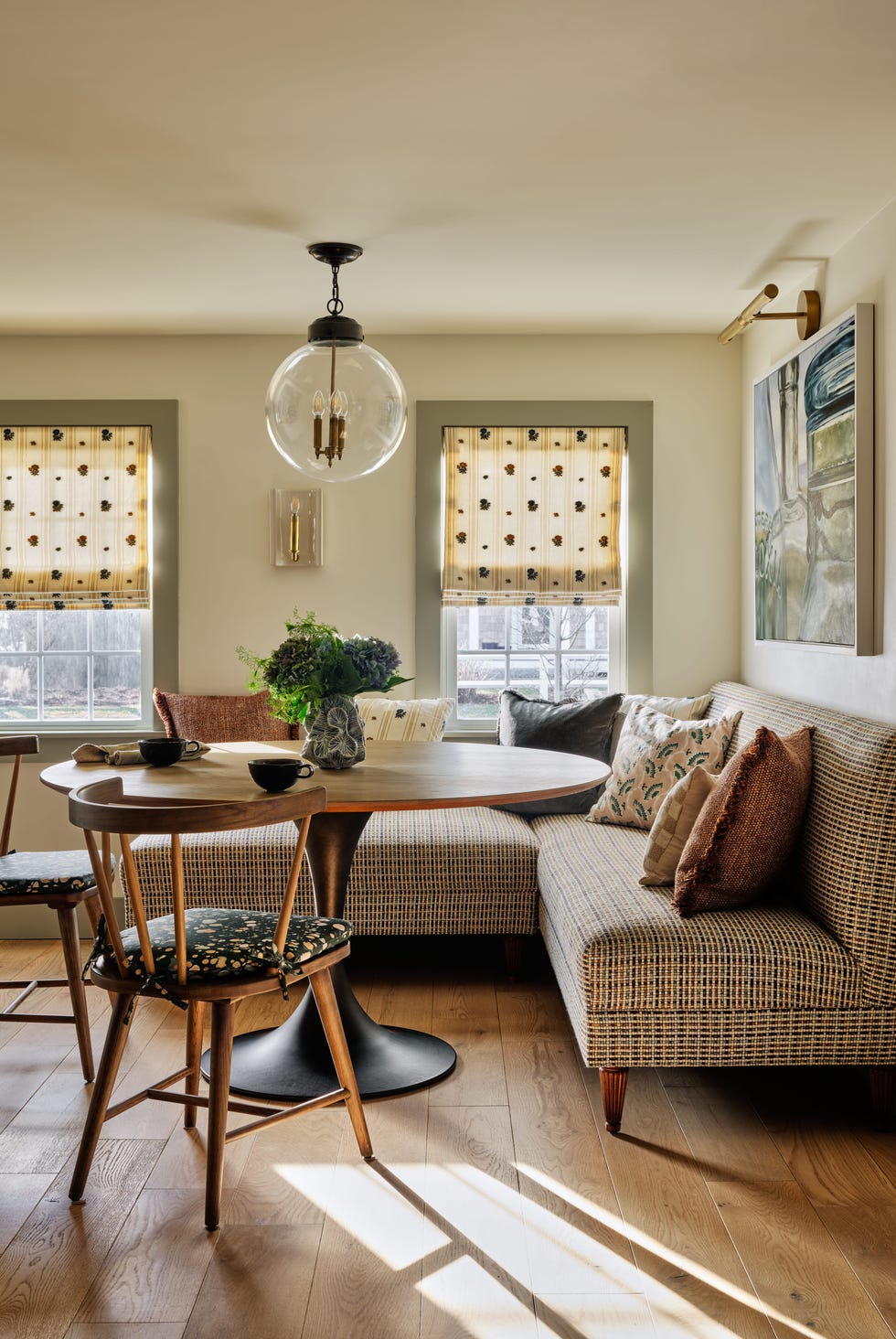
In a small layout, a large dining table can impede the flow of traffic and look too bulky.
To avoid this, designer Meghan Shadrick opted for a corner banquette instead.
“Banquettes work wonders when the dining area is small and interferes with traffic flow in and out of space,” Shadrick says.
Add Casual Elements
 Pär Bengtsson
Pär Bengtsson
Here, designer Minette Jackson chose a woven wallpaper to soften the outdoor-adjacent, formal dining room.
“The room opens right out onto our back patio, so I felt the room called for an organic element to temper the more formal pieces,” Jackson says.
“I used a neutral paper weave to add an earthy element, while the silk DeGournay panels and vintage stools give a luxe factor. I do love to entertain, and we eat here often!”
Ground the Patterns
 Emily Gilbert
Emily Gilbert
Perfecting the art of mixing prints requires using different colors and scales, something designer Colleen Simonds knew she would need to calm the busy wallpaper in this dining room idea.
“The color and glaze on the lamps help balance the tones in the wallpaper,” she explains.
The brown rug, chosen for its pops of color, grounds the entire room.
Double Your Lighting
 Stacy Zarin Goldberg
Stacy Zarin Goldberg
If your dining table is long rather than round, odds are you’re going to need more light fixtures to ensure every seat can see their plate.
Rather than recessed cans, designer Janelle Patton, founder of Lark Interiors, chose a pair of matching, dramatic chandeliers.
Create a Focal Point
 Peter Murdock
Peter Murdock
Outside of the dining table, which is usually centered, dining rooms often lack a grounding element.
In this dining room idea, designer Alexander Reid chose a contrasting, black china cabinet to draw the eye.
“I love a touch of black,” Reid says about the custom cabinet. “It makes everything around it pop.”
Create a Cozy Vibe
 Nicole Franzen
Nicole Franzen
Recreate your favorite dining establishment by mimicking hospitality design in your own home.
Key elements include moody paint colors, low lighting, and soft seating.
Take a note from the team behind Of Place Studio and combat a dark wall hue with light wood tones.
Listen to Your Architecture
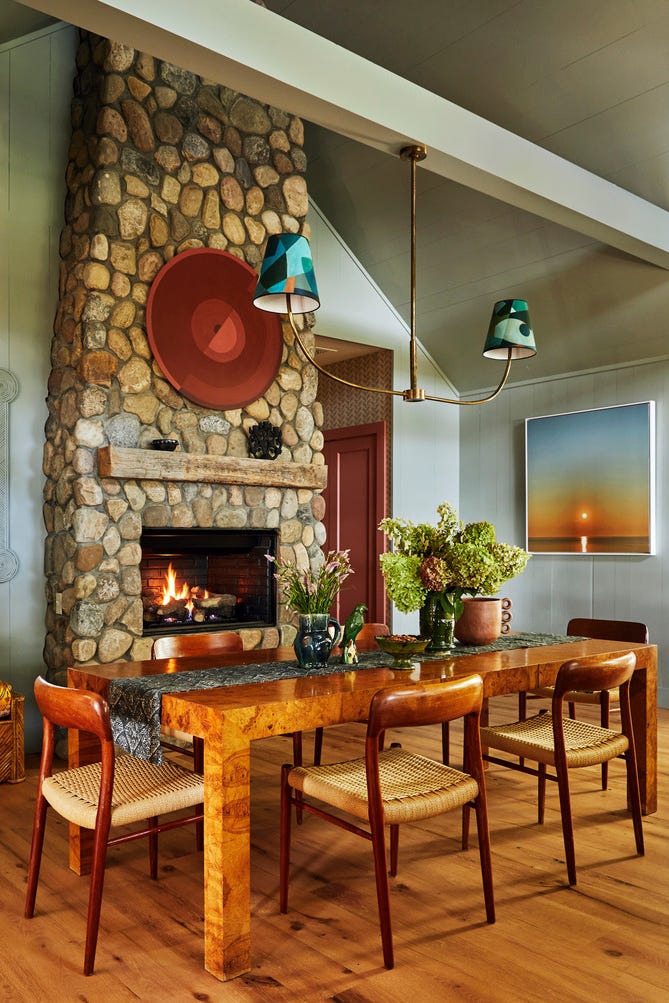 Christian Harder
Christian Harder
If you’re lucky enough to have a floor plan with personality, like Serena Dugan’s New York home, let it inform your design choices.
In this dining room idea, the painter allowed the fireplace to take center stage, keeping the rest of her furnishings minimal and in line with the home’s slightly ’70s aesthetic.
A tonal painting on the mantel ties every element together.
Let Your Seating Shine
 Read McKendree
Read McKendree
It’s not every day that dining chairs can be a focal point in design.
However, in this dining room by Palmer Weiss, the room’s fixtures were kept neutral to allow the green pattern to get its moment.
Brass cabinet knobs mirror the brass nail detailing on the upholstery.
Add a Banquette
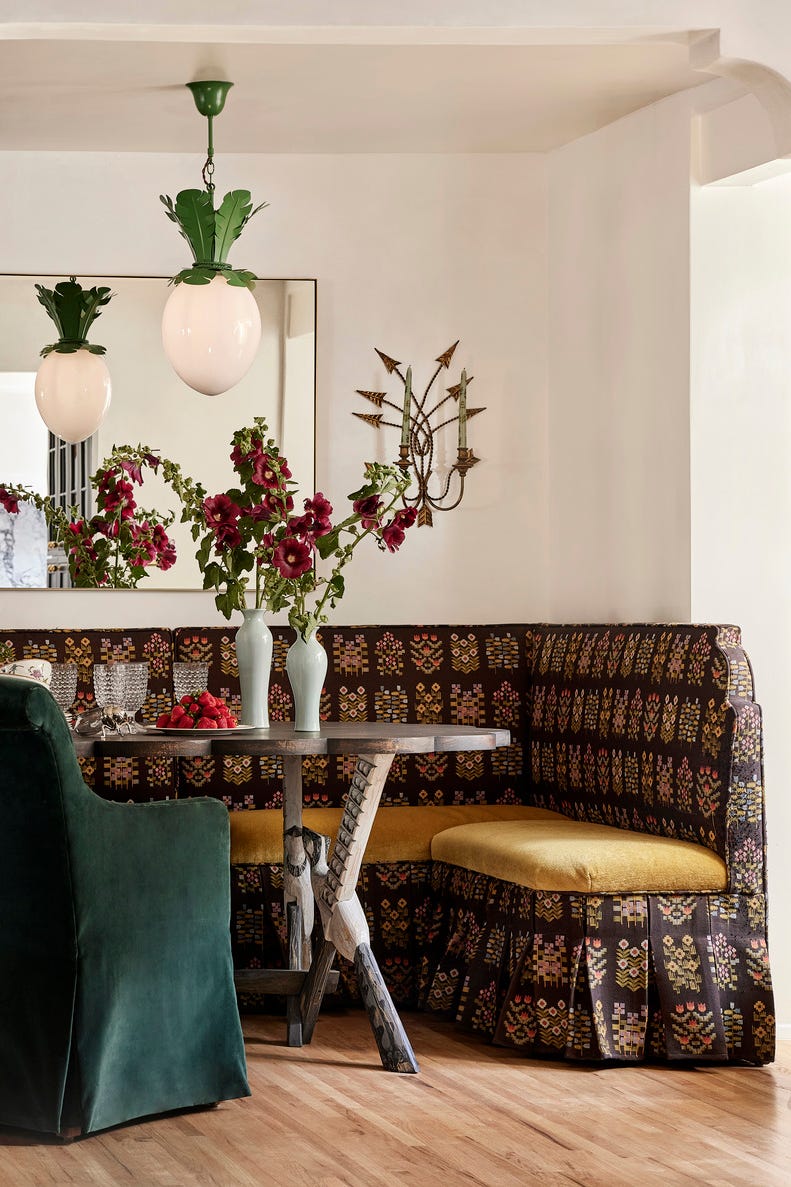 Jenna Peffley
Jenna Peffley
If the goal of your dining room is to pack in as many loved ones as possible, it’s time to try bench seating.
Take inspiration from this setup by design duo French & French.
Pleated upholstery allows the benches to still feel formal while maximizing both comfort and seat space.
Show Off Your Table Base
 Jacob Snavely
Jacob Snavely
The top of your dining table may be where all the action happens, but for pedestal-style tables, the most stunning detail is often reserved for the base.
Showcase the unique silhouette by choosing slim chairs with plenty of negative space, as designer Tina Ramchandani did with these metal-frame seats.
Repurpose a Sunroom
 ALI HARPER
ALI HARPER
Your dining room doesn’t have to be directly off the kitchen.
Take inspiration from this dining room idea by architect Pfeffer Torode and reposition your floor plan to the most sun-filled space.
The walls of windows also keep this often formal space from feeling too stuffy.
Give Yourself Options
 Nicole Franzen
Nicole Franzen
While a grand dining room works well for those who love to host, an expansive dining table can feel cold for smaller groups.
Inspired by restaurant booths and yacht interiors, designer Michael Ellison instead opted for two smaller booths so this family could dine easily, with guests or not.
Keep the Bar Close By
 sara prince
sara prince
Take a note from Rita Chan’s California home and incorporate your home bar into the dining room.
This way, guests don’t have to go far to get a refill.
This also provides valuable storage for serveware and special-occasion pieces you only want to pull out when company is over.
Embrace an Open Floor Plan
 Nate Sheets Photography LLC
Nate Sheets Photography LLC
By having the formal dining table connected to the living room, guests (and little ones) aren’t forced to remain at the table to feel like they’re still a part of the conversation.
And if you’re lucky enough to have a gorgeous view (or 100-year-old stained glass windows!), opt for a simpler dining set, as seen in this dining room idea, to let them take center stage.
Be There and Be Square
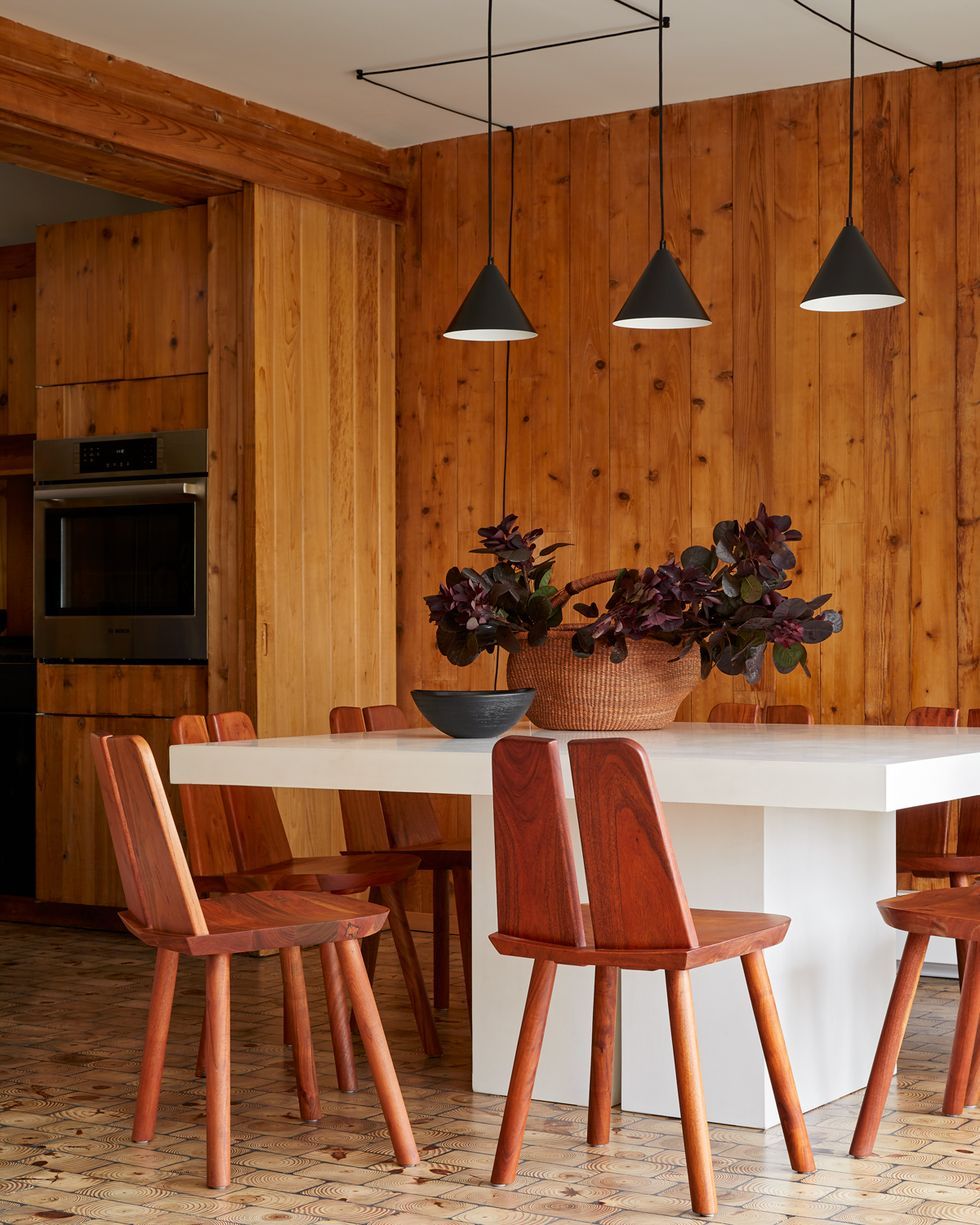 Tim Williams
Tim Williams
Rather than have all your dinner guests spread out across the dining room along a large, rectangular table, opt for a square table to bring them closer together.
This version, designed by BHDM Design, still sits eight, but now everyone is equidistant. And no one is left on the end away from the bustling conversation!
Pare Down the Palette
 Lisa Petrole
Lisa Petrole
Limiting color lets the architectural details in your space shine.
In this dining room, Magnolia styling director Ashley Maddox and designer Hilary Walker used a subtle palette to keep the focus on the cantilevered soffit and clerestory windows.
Switch Up the Seating
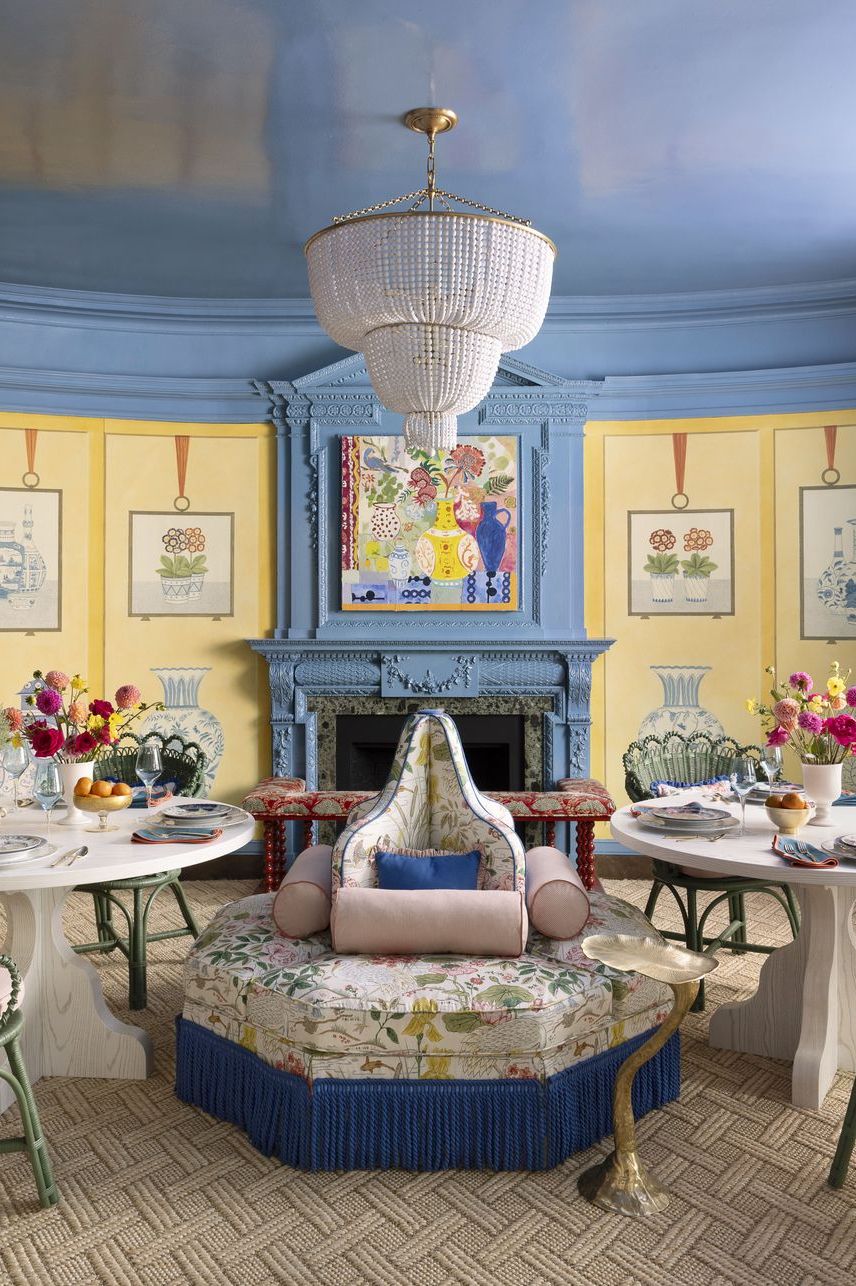 KEVIN J. MIYAZAKI
KEVIN J. MIYAZAKI
Cut to the ultimate center of attention: this circular four-seater tête-à-tête between two dining tables.
“Having two tables allows a bit more coziness and intimacy,” says Jenna Gross of Colordrunk Designs, who designed this space for House Beautiful’s 2023 Whole Home.
“In a room this size, it could get stuffy really fast.”
Bring On the Shapes
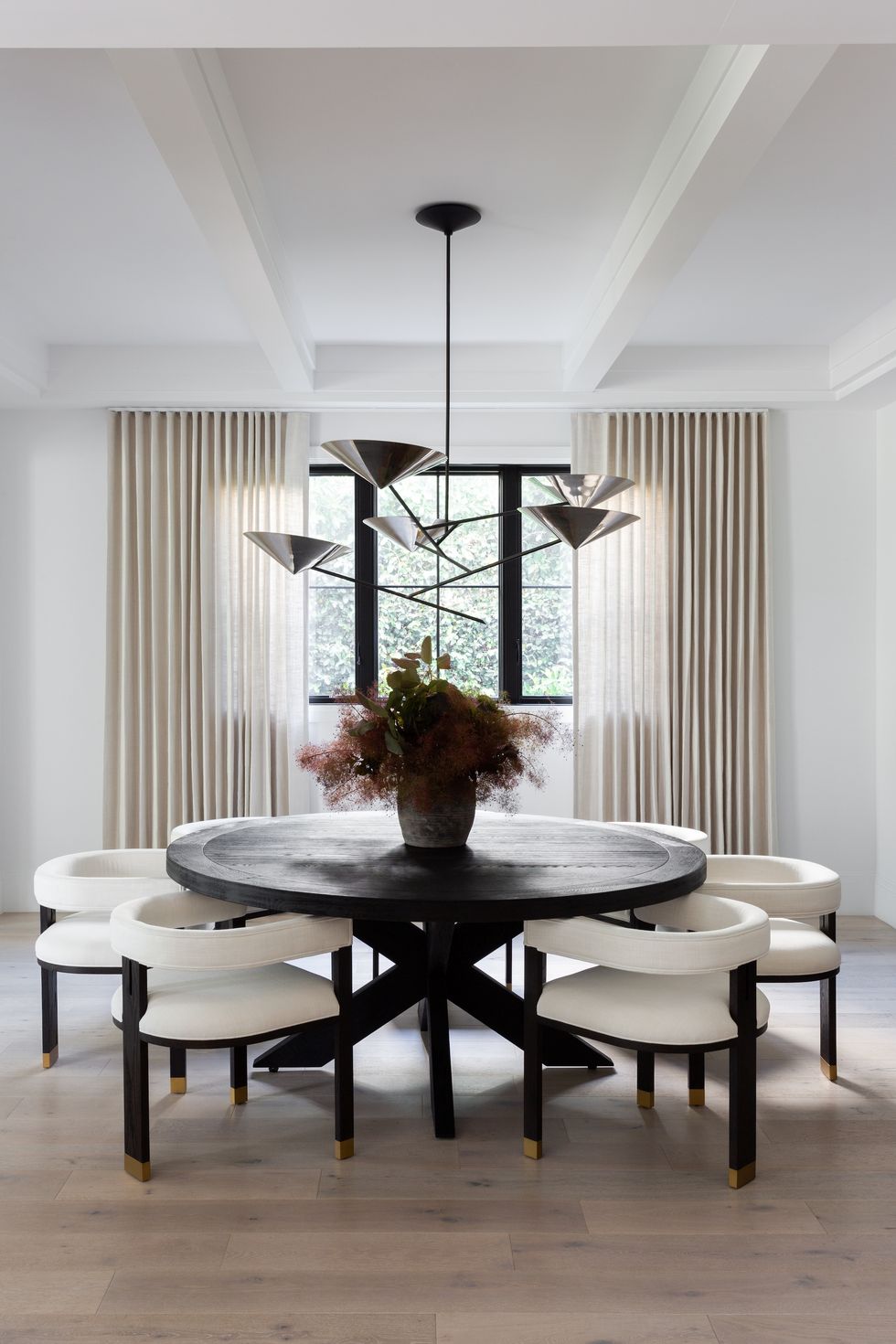 AMY BARTLAM
AMY BARTLAM
Jenn Feldman of Jenn Feldman Designs proves that a pared-down look can deliver major impact through shapes and sculptural pieces.
This dining room idea makes a statement from every angle, from the geometric pendant light to the round table and arch chairs.
Keep the Original Molding
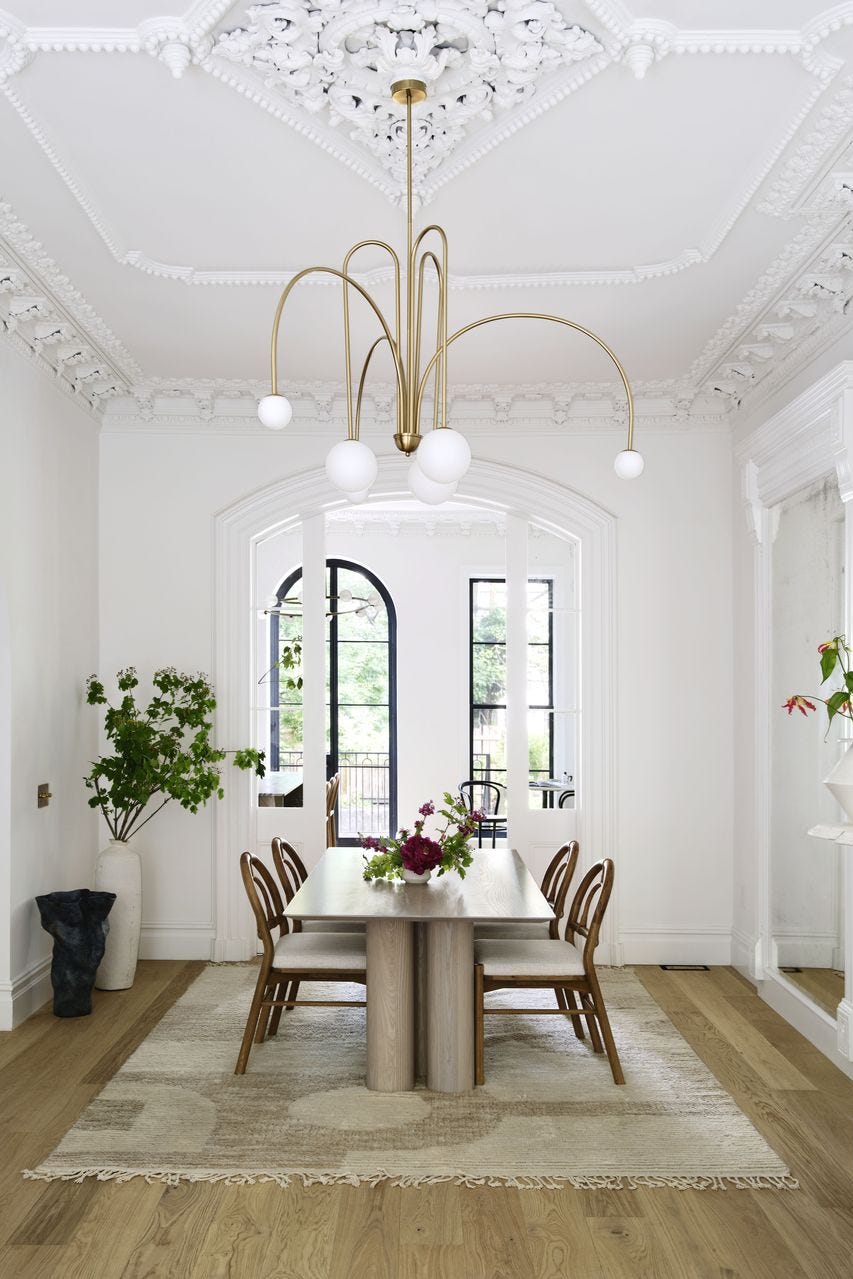 Christian Torres
Christian Torres
Jordan Slocum and Barry Bordelon of Brownstone Boys built a modern design into this 1899 brownstone in Fort Greene, Brooklyn.
The white dining room brightens up the space tremendously and allows the original molding to shine.
“It’s got some of the most ornate, gorgeous plaster medallions and molding that we’ve seen,” Bordelon says.
Add Rustic Touches
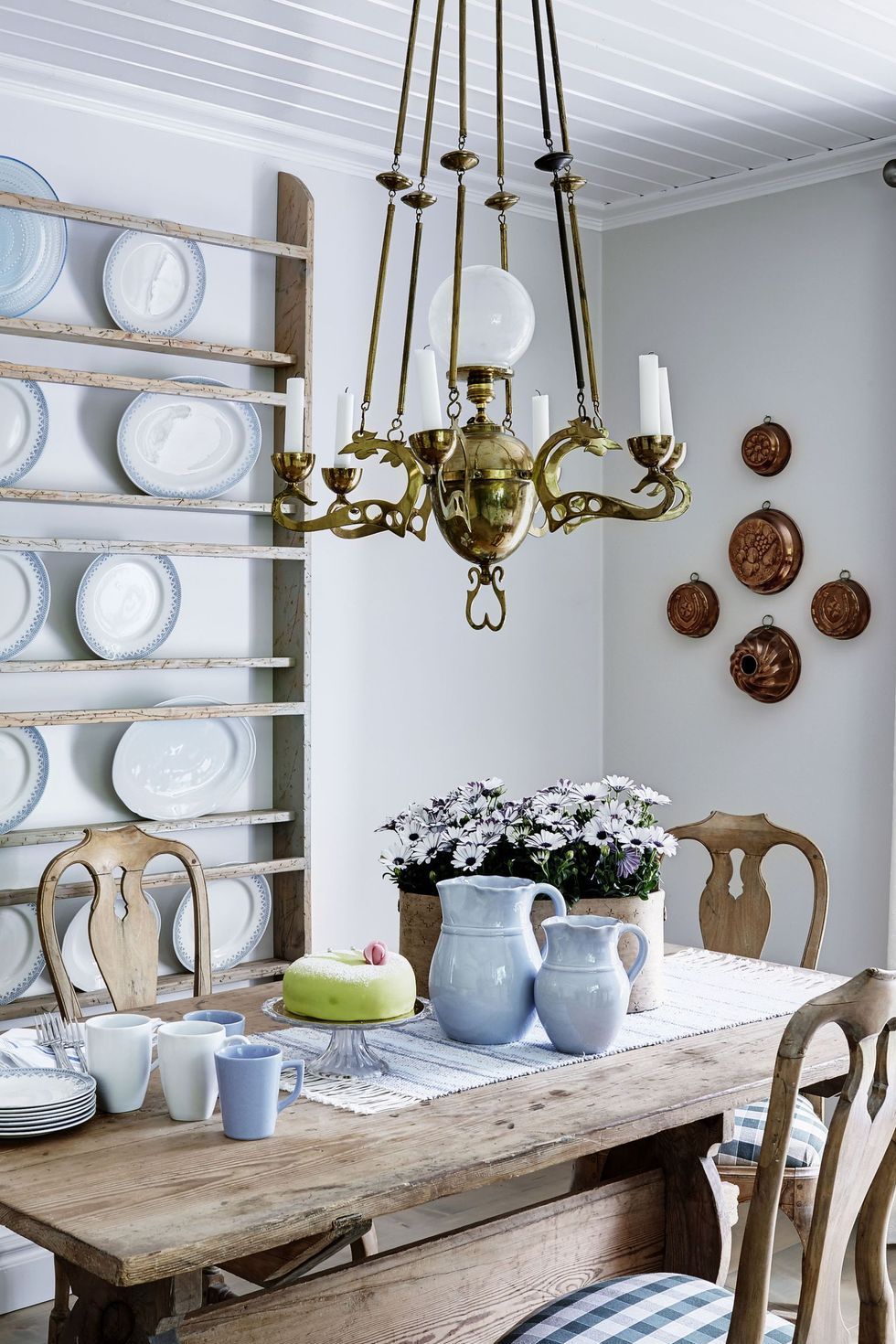 Luke White
Luke White
This dining room idea looks like it could’ve come straight from a storybook!
Designer Marshall Watson used a traditional plate rack to showcase everyday dishes as wall art in this Swedish home.
A vintage table and chairs with a blue gingham seat cushion add a touch of country charm.
Prioritize Hosting Guests
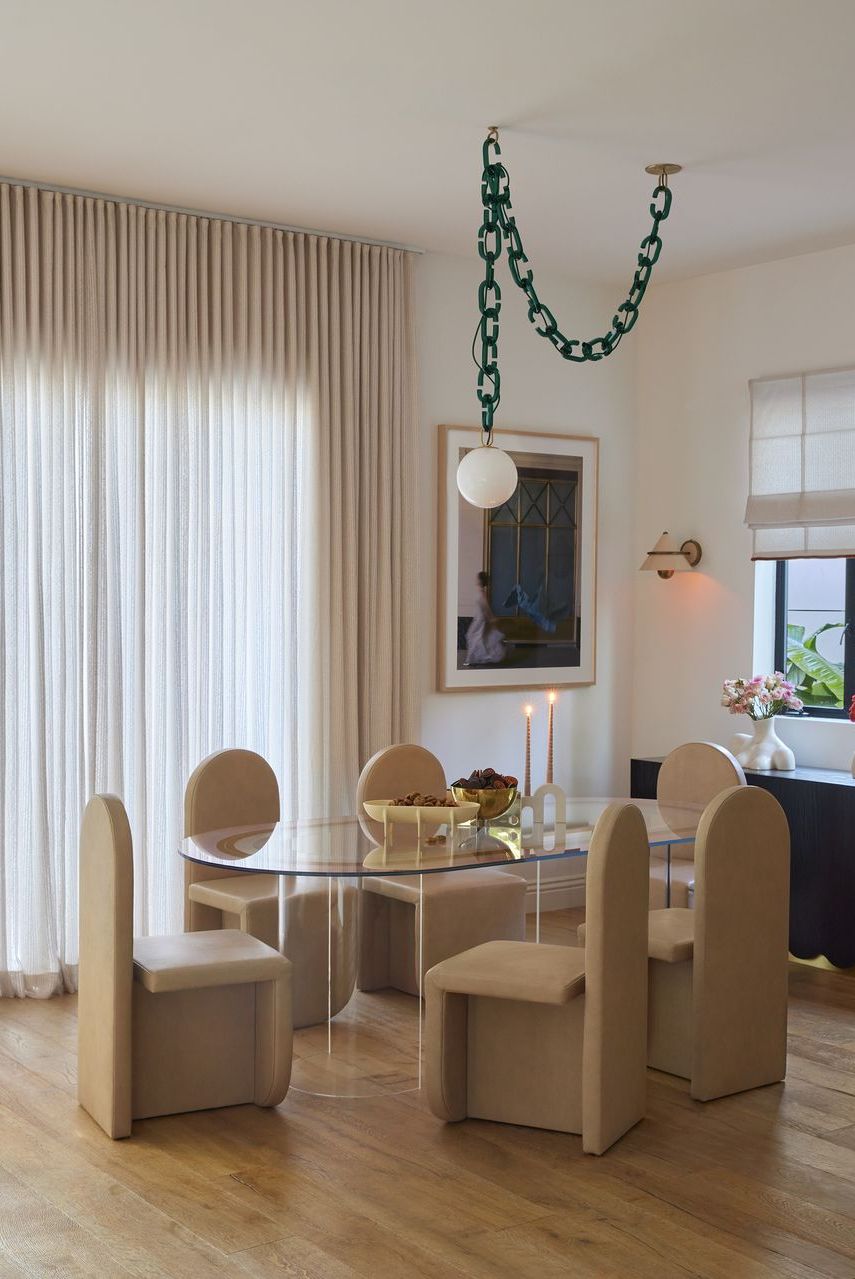 Yoshihiro Makino
Yoshihiro Makino
In a West Hollywood townhouse that gets tons of light, Tamara Honey, the principal and creative director behind House of Honey, designed a space that invites guests to hang out.
This dining room is meant to be enjoyed around the clock—not just at mealtime. “This space is used more for game night than formal dinner parties,” she explains. “We love that it feels sophisticated without being fussy.”
Lead With Details
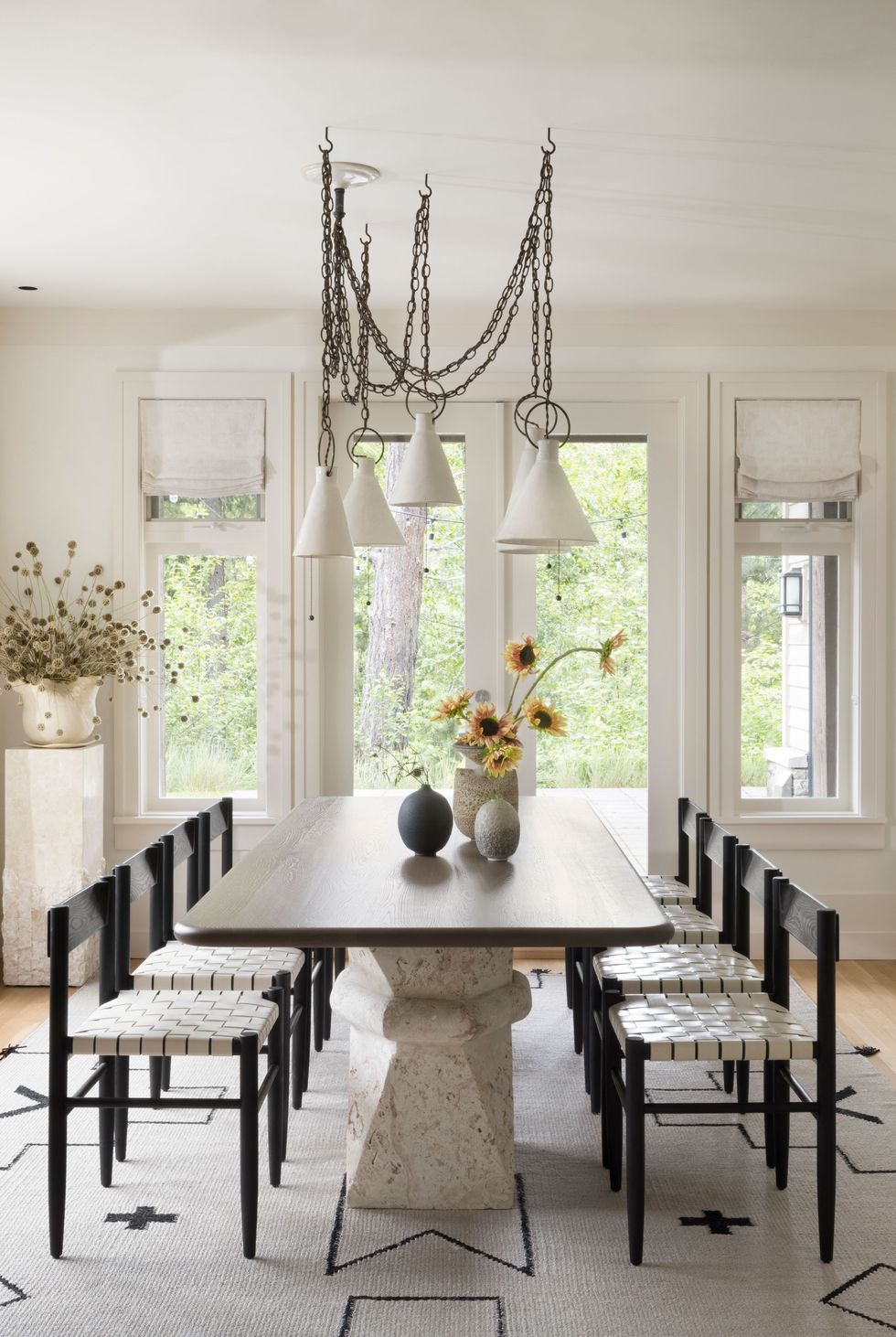 Ema Peter
Ema Peter
The gentle color palette of this dining room designed by Gillian Segal of Gillian Segal Interior Design gets an edge from black accents and contrasting textures.
From the chain links of the chandelier to vintage table bases made of solid coral, each detail brings something unique to the space.
Pair Blue and Gold
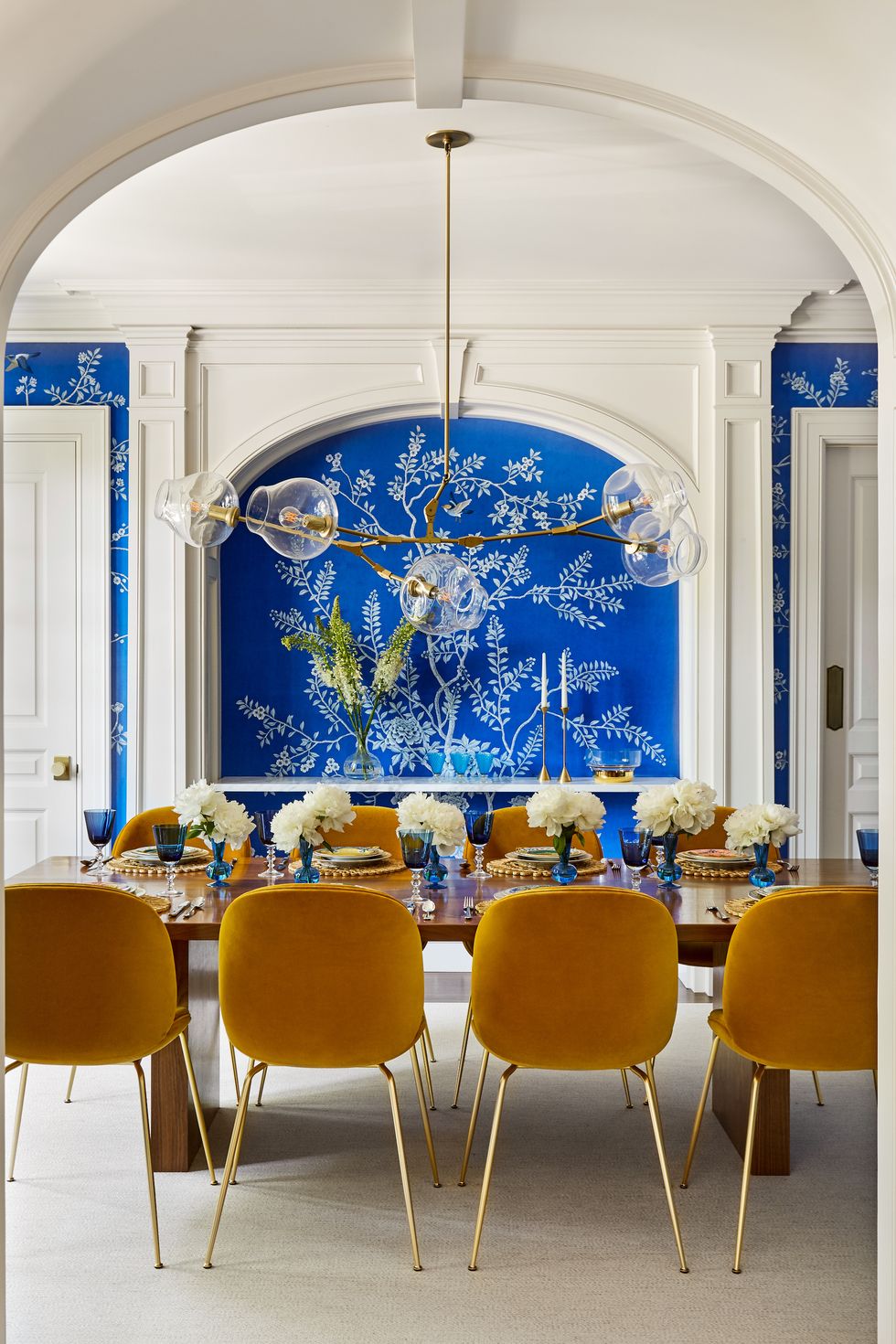 Rikki Snyder
Rikki Snyder
Next Wave designer Hilary Matt created a dining room that every color-obsessed homeowner will love.
A bold cobalt de Gournay wallpaper fills the space inside the arch molding in this dining room.
Paired with mustard velvet chairs, it gives a glamorous yet approachable invitation to sit down at the table.
Install Grasscloth Wallcoverings
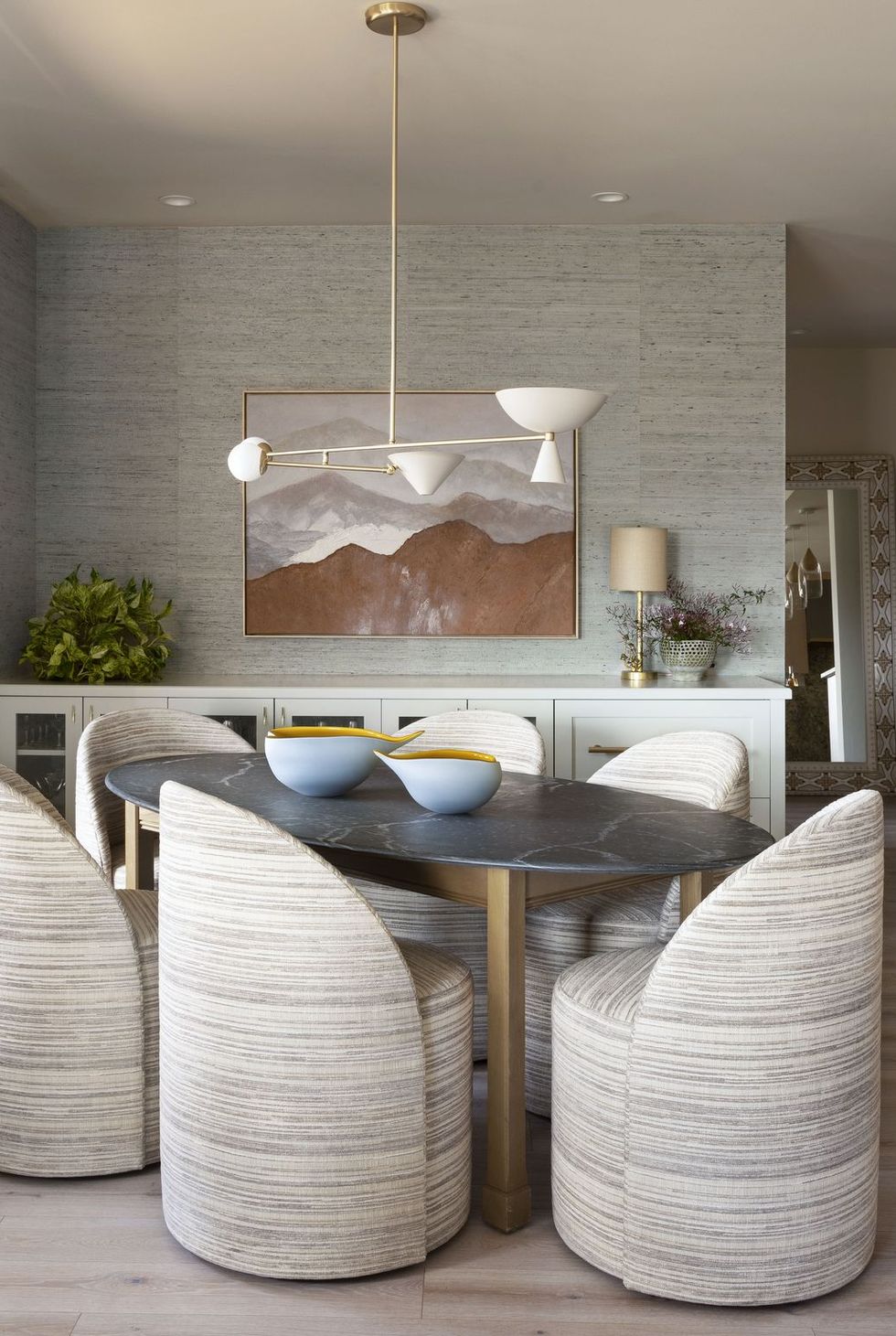 Emily Minton Redfield
Emily Minton Redfield
In an open-concept floor plan, a grasscloth wallcovering can “help define the dining space as its own,” says Julee Wray, lead designer and founder of Truss Interiors, who overhauled this Denver penthouse.
This dining room idea is filled with special touches, including the Italian-made dining table and the console that features hidden freezer drawers to offer more food storage.
Opt for a Vibrant Color Story
 KEVIN MIYAZAKI
KEVIN MIYAZAKI
Jenna Gross of Colordrunk Designs dressed this dining room in the guest quarters of House Beautiful’s 2023 Whole Home in head-to-toe coral, blue, and green.
The custom pedestal table by Aronson Woodworks functions as a card table, home office, and spot for meals.
The four velvet swivel chairs by Coley Home can be tucked under the table when the party is over.
Revamp Black and White
 Nicole Franzen
Nicole Franzen
Brit Epperson, founder of the design firm Studio Plow, took on the challenge of giving this historic San Francisco townhouse a makeover in just five weeks.
With minimalist but high-end touches of black and sculptural art, she designed a home that feels current and elevated and can easily be built upon.
This dining room idea showcases multiple finishes and materials with an airy, cool flair.
Honor Passed-Down Furniture
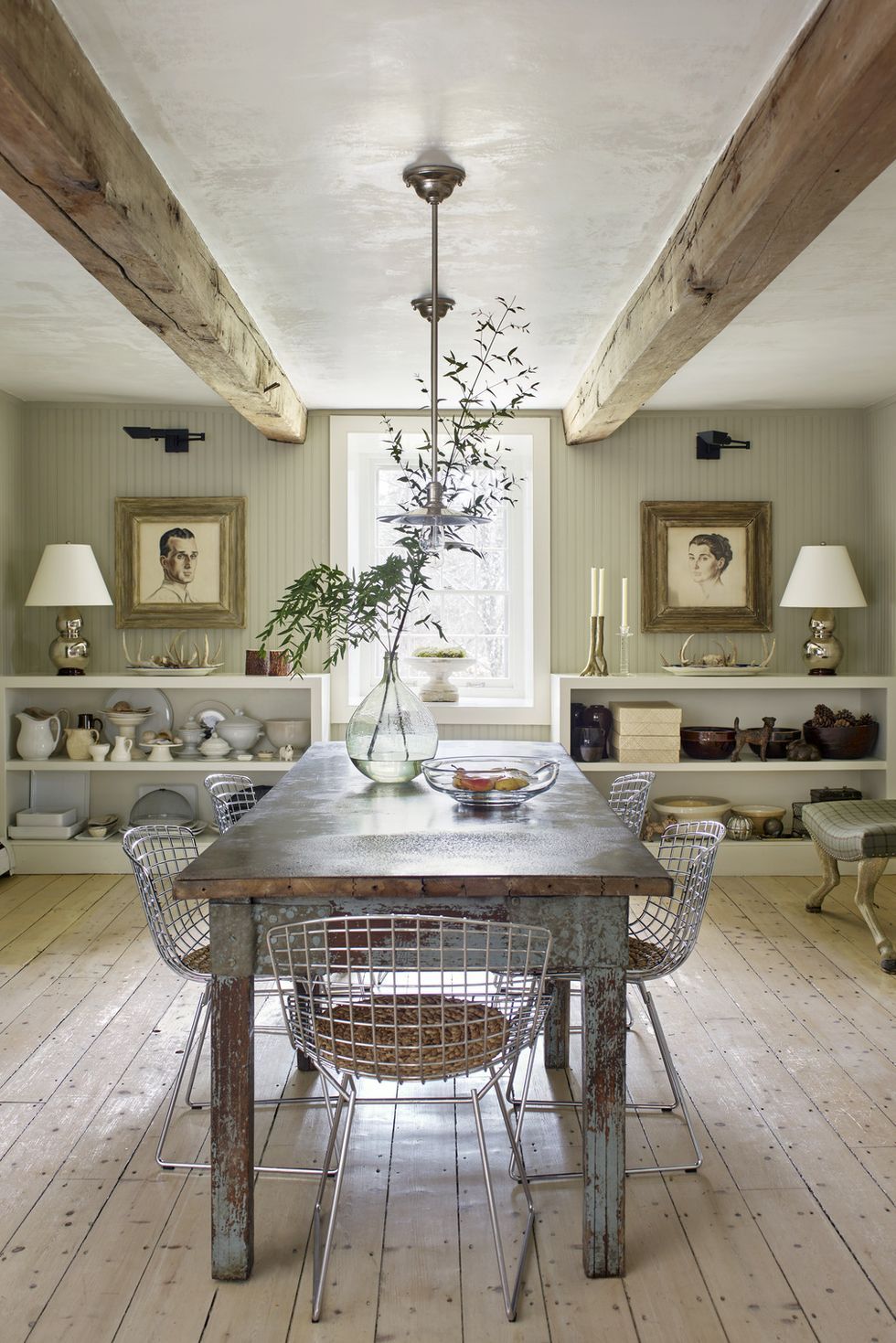 Francesco Lagnese
Francesco Lagnese
Phillip Smith was in search of a dining table for his Rhinebeck, New York, weekend house when “a friend of mine’s mother passed,”
he says. “I adored her, and when my friend went through her things she said, ‘There’s a table here with your name on it!’ I was nearly in tears.”
The gray-blue patina looks beautiful next to the chrome chairs and green-gray wall paint. It also contrasts softly with the off-white ceiling.
Make a Bookcase the Centerpiece
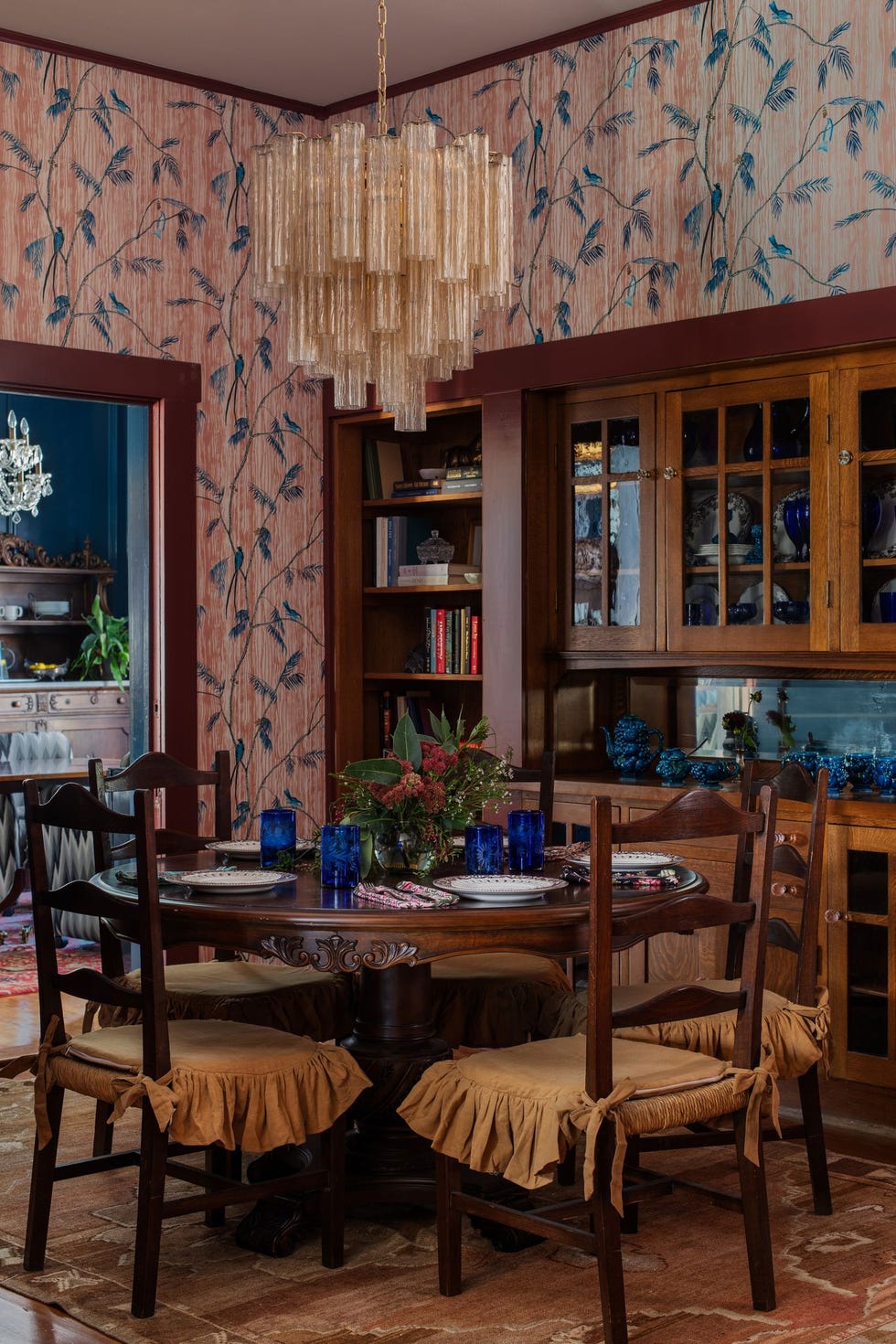 Avery Nicole Photography
Avery Nicole Photography
This dining room is full of eye candy, starting with the personal library that’s its centerpiece. Designer Sarah Stacey says,
“For this bookshelf, we made sure to balance the styling of them not only on each shelf, individually, but throughout the entire bookcase so that your eye moves around.”
The result, she adds, “showcases a refined taste and love for a curated life.”
Paint It Dark Green
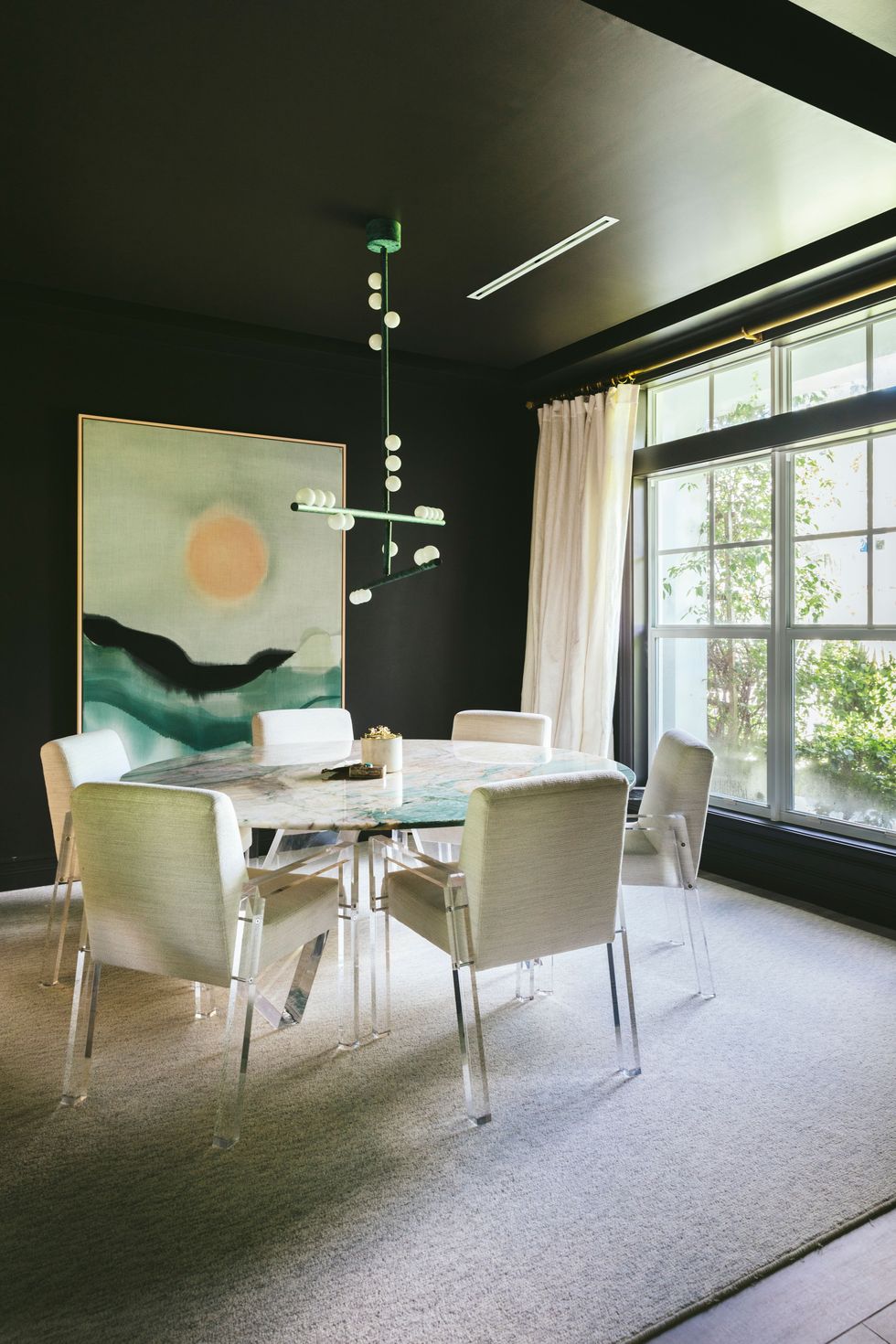 Ema Peter
Ema Peter
Here’s one way to bring the outdoors in with ease.
The deep green walls of this dining room idea designed by Gillian Segal Interior Design create mystery and intrigue.
The sculptural chandelier and mixed material dining chairs add eclectic charm.
Reupholster the Furniture
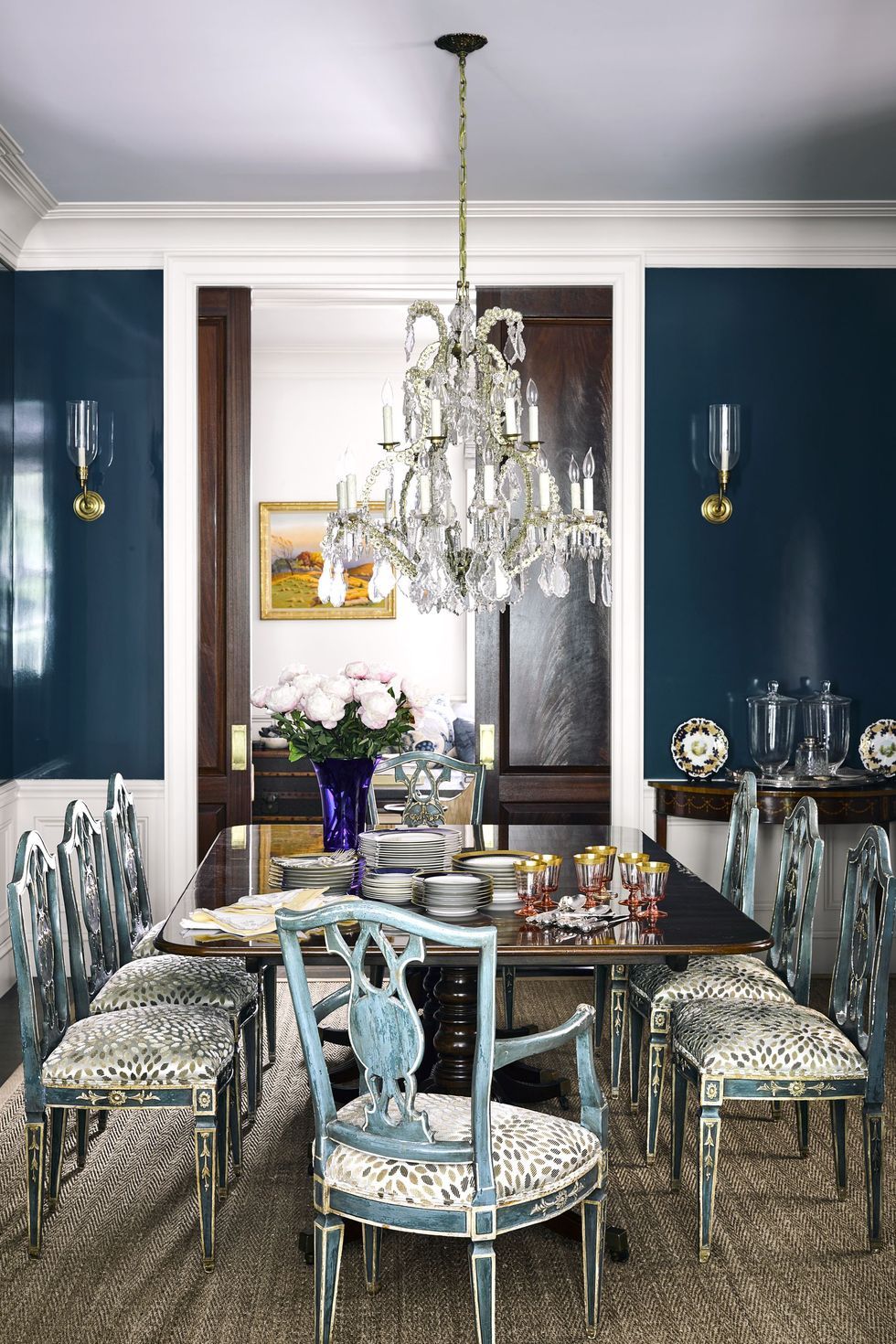 Douglas Friedman
Douglas Friedman
In the elegant dining room of this Manhattan duplex designed by Garrow Kedigian, a circa-1900 mahogany table is surrounded by antique chairs that were purchased at a Paris flea market and re-covered in a Schumacher velvet.
The high-gloss finish of the deep berry blue walls reflects the ornate chandelier.
Consider a Japandi Makeover
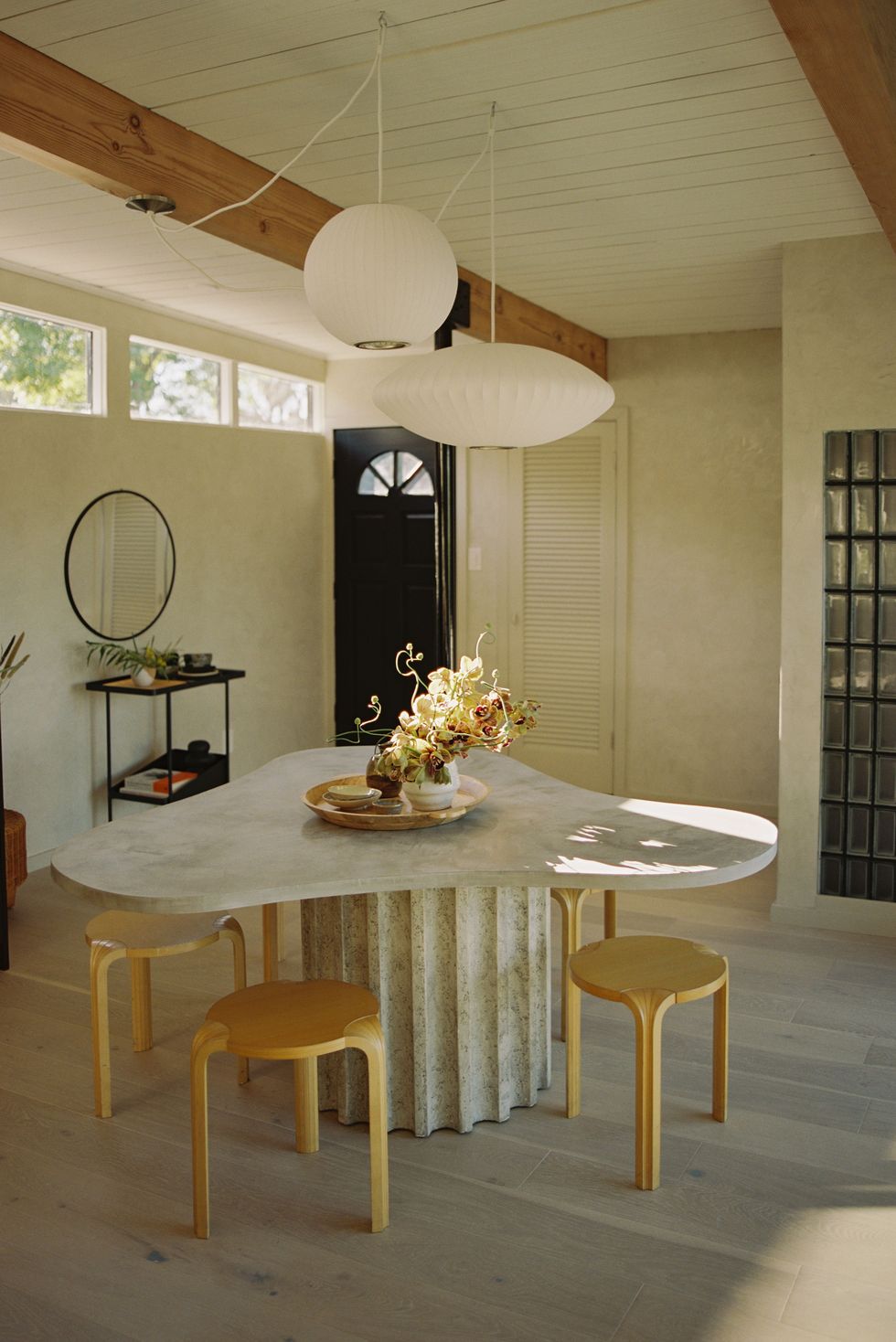 Justin Chung
Justin Chung
The Japandi design style of this dining room idea by Joel Wong and Amanda Gunawan of OWIU Design rings true.
Natural light enters through the clerestory windows and plays on the plants, wood, and organic materials.
The dining table is only a few inches taller than a traditional coffee table.
Infuse Wall Niches With Color
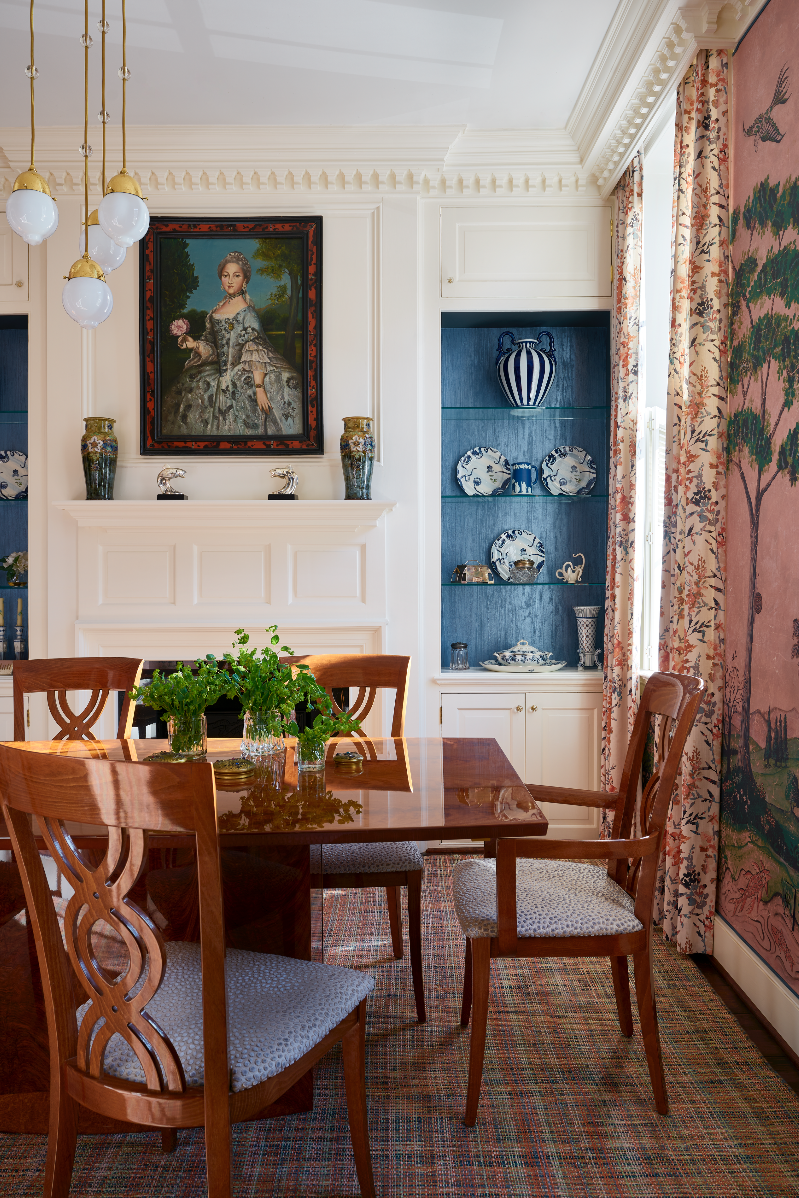 Add Color to Niches
Add Color to Niches
It’s easy to fill wall niches in your dining room with decor, but you can emphasize them even more with a simple wallcovering.
In a this Virginia dining room, designer Joe Ireland used a handmade tissue wallcovering by Twin Diamond Studios to set an elegant backdrop for decorative plates.
Mix Up the Upholstery and Finishes
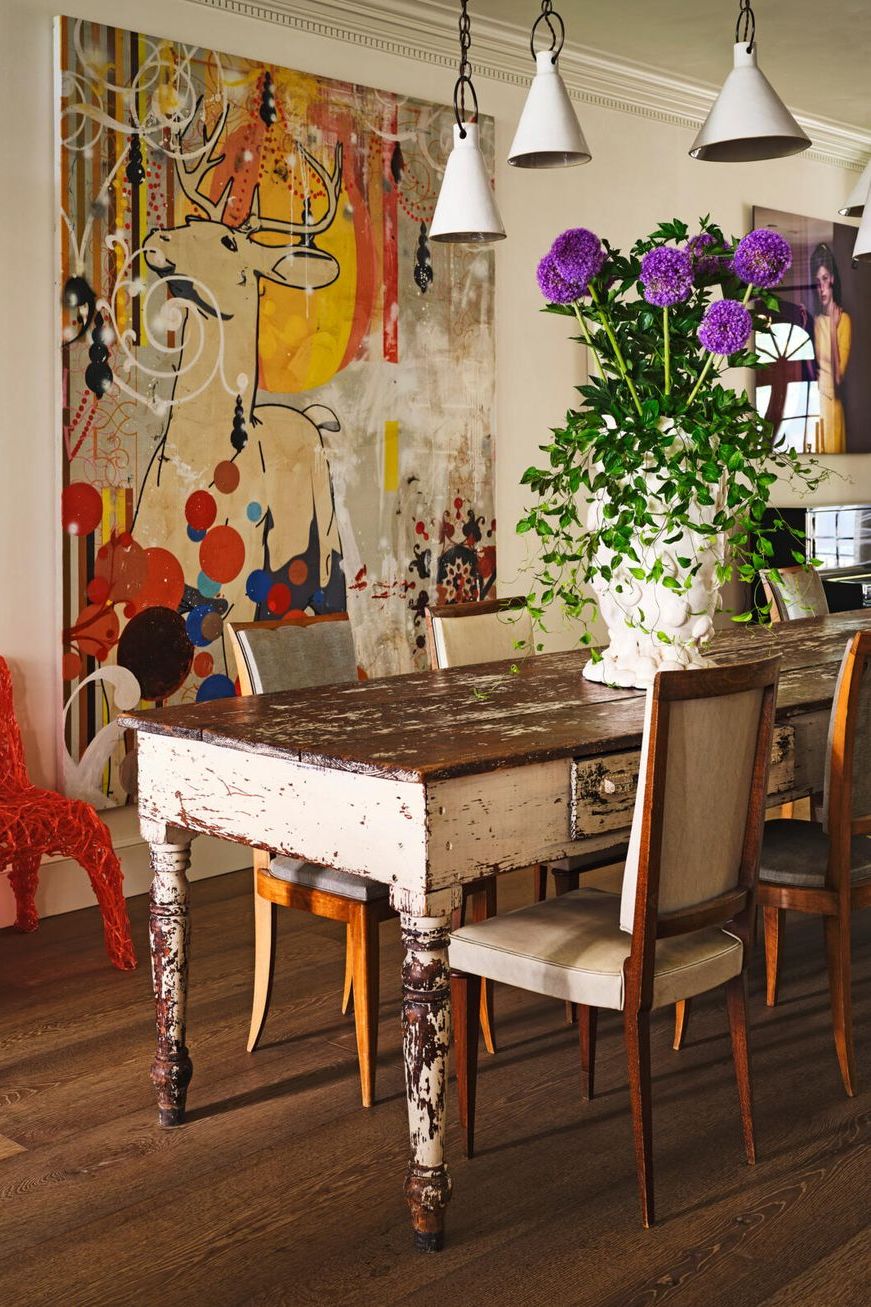 Frank Frances
Frank Frances
If you like the idea of mixed dining chairs but still appreciate an element of cohesiveness, try different takes on a single style.
Here, design duo Cortney and Robert Novogratz surrounded the 12-foot-long dining table in their West Village home with the same chair in several different neutral fabrics and wood finishes.
Add a Floor Mirror
The dining room is an ideal place to decorate with mirrors.
Blogger Ursula Carmona from Home Made By Carmona leaned a tall, gold-trimmed floor mirror against her dining room wall to reflect natural light double views.
Try a Linen Tablecloth
A naturally rumpled linen tablecloth can make your dining room feel cozier than a bare table.
This Scandi dining room from Fantastic Frank has matching curtains for a casual but coordinated look.
Create an Entertaining Spot
:max_bytes(150000):strip_icc():format(webp)/Chango_East_Hampton_-10472NewR1-9e423d9c863046aa9a1fd6c89c7a3d55.jpg) Design by Chango & Co. / Photo by Raquel Langworthy
Design by Chango & Co. / Photo by Raquel Langworthy
Choose an extra-large table to turn your dining room into an entertaining-ready hub.
Chango & Co. anchored the 12-seat table with a trio of oversized pendants and helping to create a sense of intimacy in the high-ceilinged room.
Add Classic Wainscoting
Dining room wainscoting is a classic.
This Swedish country dining room from Fantastic Frank has a wainscoting detail around the perimeter of the room with a classic picture ledge that is sparsely decorated with art and objects as a nod to history without feeling too stuffy or old-fashioned.
Create a Sunroom Dining Room
:max_bytes(150000):strip_icc():format(webp)/HG101Luttner-Sunroom-3_1800-85d1e16588b74111bfe1398b9318d398.jpg) Design by Leanne Ford Interiors / Photo by Erin Kelly
Design by Leanne Ford Interiors / Photo by Erin Kelly
Place your dining table in another room to create a dedicated spot for hosting meals.
This updated 70s Pittsburgh home from Leanne Ford Interiors has a sunroom dining room with wraparound windows and whitewashed finishes that has sweeping views of the outdoors.
Make It Cozy
:max_bytes(150000):strip_icc():format(webp)/DesignbyRyannMillerPhotobySaraLigorria-Tramp_9-ace9c057e33444d19c3397da309f45f2.jpeg) Design by Ryann Miller For Emily Henderson Design / Photo by Sara Ligorria-Tramp
Design by Ryann Miller For Emily Henderson Design / Photo by Sara Ligorria-Tramp
It can be a dining room mistake to push the table up against the wall.
But if your dining room is a pass-through space off the kitchen, create a cozy space for two against the wall, and pull the table into the center of the room when you have guests.
Clad the Ceiling in Wood
:max_bytes(150000):strip_icc():format(webp)/180325-CK_Pine_Ave_013-f400b05cd71f40f98d12f53c76e0f8d0.jpg) Design by Christina Kim Interior Design / Photo by Raquel Langworthy
Design by Christina Kim Interior Design / Photo by Raquel Langworthy
Create a warm and cozy feel with a wood ceiling.
This dining room from Christina Kim Interior Design has a reclaimed wood ceiling detail that contrasts with the white shiplap walls, adding warmth, texture, and a surprise element.
Pair Navy With Gold
:max_bytes(150000):strip_icc():format(webp)/61c582f03758c59b9728b6cd4dafc2243066021b-1600x1200-fe76a757c4664bcabdd77e488b6047cb.jpeg) Design by Tyler Karu / Photo by Erin Little
Design by Tyler Karu / Photo by Erin Little
Pair dark wall paint with gold accents for a regal feel.
Deep saturated navy paint on the walls makes a strong foil for gold accents in this dining room from Tyler Karu.
Add a Standing Centerpiece
:max_bytes(150000):strip_icc():format(webp)/IMG_1070-194ad896c4ed476da2e9b3f505624e37.jpg) Design by Forbes + Masters
Design by Forbes + Masters
Create a permanent centerpiece on your dining room table to keep it from looking too empty when not in use. Forbes + Masters paired a chunky blond wood dining table with a set of dramatic black tapered candlesticks of varying heights.
Hang Floating Shelves
Hang chunky natural wood floating shelves for a modern feel.
This built-in buffet with an arched opening from A Beautiful Mess is painted in a feel-good shade of pink.
Add a Dramatic Accent Wall
Create instant drama with a wallpaper accent.
This dining room from Michelle Berwick Design is defined by multicolored floral wallpaper.
Keep It Traditional
:max_bytes(150000):strip_icc():format(webp)/diningroom1-e6a86c0c9ef3494a80529b8a2394d7b0.jpg) Design by Nile Johnson Interior Design
Design by Nile Johnson Interior Design
Keep a traditional dining room from feeling too formal with a mix of colors and styles.
This dining room from Nile Johnson Interior Design is a lively take on traditional style that mixes soft green wall paint with a crystal chandelier, a red and blue vintage rug, antique carved wood sideboards, and a mix of upholstered chairs.
Hang Tall Drapes
:max_bytes(150000):strip_icc():format(webp)/YorkBeachCapeNeddickMaineDiningRoom-07efe370386c4222bfe985ae98af8bff.jpg) Design by Tyler Karu
Design by Tyler Karu
Floor-to-ceiling drapes will add coziness to your dining room.
This dining room from interior designer Tyler Karu is warm and inviting, with its honey-colored wood tones, leather seat covers, dramatic woven pendant light, and homey table lamp with a warm fabric shade set on the sideboard.
Mix Old and New
:max_bytes(150000):strip_icc():format(webp)/BOTSFORD21-1603321a1e8b4094915b8e5fad9961fd.jpg) Design by Michelle Berwick Design
Design by Michelle Berwick Design
Combine old and new elements to add interest to your dining room. Michelle Berwick Design combined an antique dining table with a modern sideboard and chairs and a cowhide rug in this space.
Hang a Round Mirror
:max_bytes(150000):strip_icc():format(webp)/c0934d_7888633c7cfa4f95a8187053e87f8ceamv2-1-d387fa49a8044b94aee4846ec3dce690.jpeg) Design by Leclair Decor
Design by Leclair Decor
Hang a large round mirror to add light to a wall of built-ins.
This dining room from Leclair Decor has a contemporary version of an old school built-in sideboard wall with surrounding storage cabinets for dishes, tableware, and seasonal decorations to maximize storage space.
Plant a Tree
:max_bytes(150000):strip_icc():format(webp)/GRACEAVENUEJennPabloStudio-56a65a0915f5470983606080686104e0.jpeg) Design by Jenn Pablo Studio
Design by Jenn Pablo Studio
Bring the outdoors inside with a potted indoor tree.
This dining room from Jenn Pablo Studio mixes upholstered bench seating with wooden dining chairs to create a serene and minimalist look.


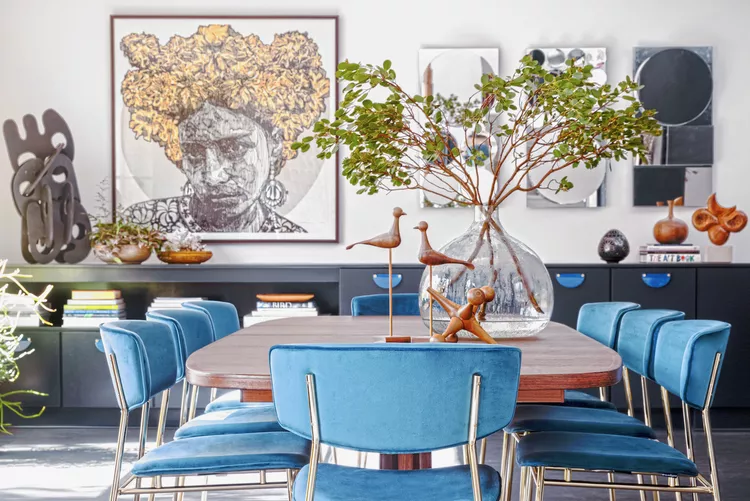
:max_bytes(150000):strip_icc():format(webp)/Chandelier-and-magnolia-in-dining-room-c2a93a52007d46348748ed9158c0fea3.jpeg)
:max_bytes(150000):strip_icc():format(webp)/MED541B6F839A1846AAB434DE30FF80E073-26642759ec574c80966a332017ec3ccb.jpg)
:max_bytes(150000):strip_icc():format(webp)/MED4E28DE66CDC94C7688C546C31B56FA90-32c4941b12fa4b188edf617457945fcd.jpg)
:max_bytes(150000):strip_icc():format(webp)/Pink-arch-buffet--1365x2048-ed37222f5ec247b2855971d4cf3d5cb0.jpg)
:max_bytes(150000):strip_icc():format(webp)/MCH_1838-fe9bfebff32c40f997956b8ade9f8366.jpg)